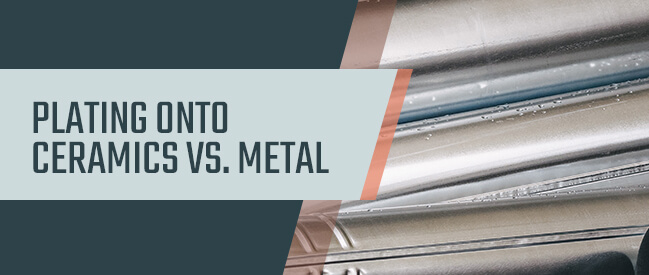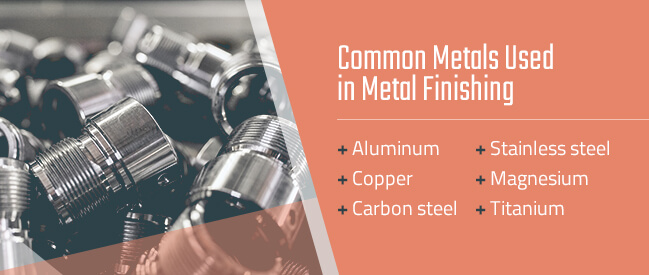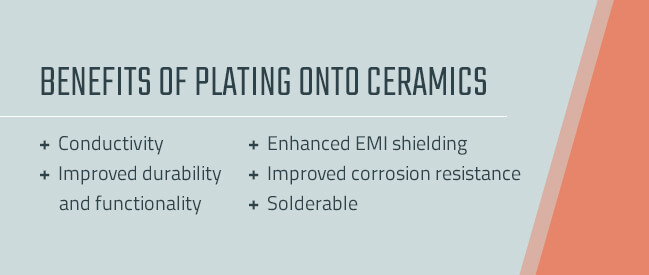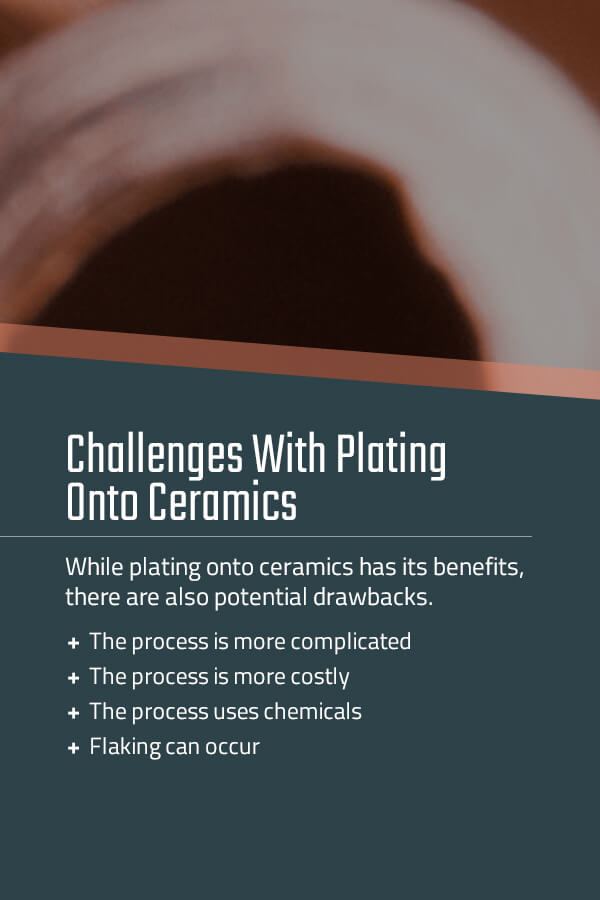Plating is a process that places a thin layer of metal onto another surface. The other surface can be any number of different materials, such as another type of metal, ceramics, glass or plastic. No matter the surface, or substrate, metal finishing offers numerous benefits, such as enhancing electromagnetic interference (EMI) shielding and strengthening the object.
There are some notable differences between metal and ceramics plating. The strength and electrical conductivity of the finished product often depend on the base material. The process of ceramics plating vs. metal finishing is also slightly different.
A comparison of metal and ceramics plating will help you see the difference between the two methods and when one is more appropriate than the other.
Common Ceramic Materials Used in Metal Finishing
A variety of ceramic materials can be plated:
- Alumina: Also called aluminum oxide, alumina1 is produced from bauxite rock. It is a long-wearing, hard material often used in medical devices. Alumina is erosion and chemical-resistant. It can withstand temperatures up to 2900 degrees Fahrenheit.
- Lead zirconate titanate (PZT): Lead zirconate titanate (PZT) is a piezoelectric ceramic material. A piezoelectric material changes shape when subjected to an electric field. PZT is currently one of the most commonly used piezoelectric ceramics. It is often used in motors and chips for medical devices2.
- Silicon: Silicon is the second most common element on Earth3, forming 27% of the planet’s crust. It is a member of the carbon family and has many applications, most notably in computer chips and semi-conductors.
- Silicon carbide: Silicon carbide is a compound made up of carbon and silicon. It is used in semi-conductors and forms the basis of cutting and abrasion tools used by artists and factories.
- Tungsten carbide: Tungsten carbide is a material made up of carbon and tungsten. In its natural form, it is a grayish powder. Tungsten carbide can be pressed into shapes and used to create cutting tools.
Common Metals Used in Ceramic Plating
Some types of metals are better suited for plating onto ceramics than others. A few commonly used metals include:
- ENIG: Electroless nickel immersion gold (ENIG) plates the ceramic material with electroless nickel and gold. ENIG creates strong electric performance and oxidation resistance. The finished product also has good thermal diffusion properties and temperature resistance. It is most often used in low-end consumer products.
- ENEPIG: Electroless nickel electroless palladium immersion gold (ENEPIG) is similar to ENIG, with the addition of a palladium layer between the nickel and gold. The palladium acts as a barrier, keeping the nickel from diffusing into the gold.
- Silver: Silver is a precious metal with many protective properties, including corrosion resistance and high-temperature resistance. It is also lightweight and antibacterial.
- Copper: Copper resists corrosion, is highly malleable and has a high electrical conductivity. Those three features make it an ideal metal for plating onto ceramic, particularly ceramics used to make telecommunication devices and electronics.
Common Metals Used in Metal Finishing
The metals used in metal finishing can act as the base material or the coating. Metals that typically serve as the base material include:
- Aluminum
- Copper
- Carbon steel
- Stainless steel
- Magnesium
- Titanium
The metals used as coatings are similar to those used for plating onto ceramics. Typically, when metal is the base material, many metals can act as the coating. For example, tin is ideal for plating onto metal but not onto ceramics. Some other metals often used as coatings include:
- Copper: Copper has many applications, thanks to its heat resistance and conductivity.
- Gold: Gold is also highly conductive, making it good for circuits and semi-conductors. One drawback of gold is its high price.
- Nickel: Nickel can be either electroless or electrolytic. It has good conductivity and wear resistance. Electroless nickel is more corrosion resistant than electrolytic.
- Silver: Silver is less corrosion resistant than other types of metal. It makes up for its limited corrosion resistance by being highly conductive.
- Tin: Tin is a cost-effective coating material. It has good corrosion resistance and contact resistance. Tin is sometimes mixed with other metals to improve its wearability and strength.
Comparing the Plating Process
The plating process is slightly different when ceramic is the base material instead of metal. Compare the two different processes:
Ceramic Plating Process
A notable feature of plating on ceramic is that it requires an additional step. To create a surface that can undergo electroplating, it is necessary first to coat the ceramic with electroless nickel. The process is as follows:
- Cleaning: The material should be cleaned to remove dust, dirt and debris.
- Etching: The material is dipped into a solution that roughs up the surface. After etching, the material needs to be cleaned again.
- Catalyzation: Once the material is etched and cleaned again, it is submerged into a bath of electrolytes. The electrolytes are catalysts that cause the nickel to coat the ceramic material.
- Plating: After the ceramic gets coated with the nickel, it can be electroplated with the metal of your choice, such as gold, silver or copper.
Metal Finishing Process
The process of plating onto metal is generally less complicated than plating onto ceramic, as you can skip the electroless nickel plating step. The plating onto metal process is as follows:
- Cleaning: The metal base material needs to be cleaned to remove dust, debris and dirt from the surface.
- Activation: An activator is applied to the surface of the metal. The activator acts as a catalyst for the electroplating
- process.
- Etching: Some metals need to be etched, meaning they get submerged in an acidic solution. Etching roughs up the metal’s surface so that it can absorb the plating better. Etching usually comes before activation.
- Plating: The plating process can vary based on the type of metal and the goal. Rack electroplating is a cost-effective method, as it keeps all the parts together. Barrel electroplating submerges all parts into a large barrel filled with the coating material. It is also possible to use electroless plating with metal base materials. With electroless plating, a chemical reaction allows nickel to coat the base material.
Comparing the Benefits of Plating Onto Ceramics vs. Metal
If plating onto ceramics is more complicated than plating onto metal, you might wonder why it would be worth the time and effort. Each type of plating has its benefits. Depending on your needs and goals, either plating onto ceramics or plating onto metal might make sense, so knowing the differences between metal and ceramics plating is key.
A few benefits of plating onto ceramics include:
- Conductivity: On its own, ceramic does not conduct electricity well. Adding a metal coating creates a metalized surface that can carry an electric current. If you are in the electronics industry, plating onto ceramics allows you to use ceramic base materials in the products you create.
- Improved durability and functionality: The hardness of ceramic material can vary considerably based on the type. Adding a metal coating increases the strength and hardness of the material. Plated ceramic also becomes more scratch and chip resistant and more resistant to other kinds of damage.
- Enhanced EMI shielding: Certain types of devices need protection from EMI, such as medical devices. Some metals enhance EMI shielding, making them ideal for use when plating ceramic.
- Improved corrosion resistance: Ceramic materials are typically naturally able to resist corrosion. Adding a metal coating, particularly a metal with a high level of corrosion resistance, supplies another layer of protection against rust and moisture damage.
- Solderable: Plating onto ceramic can improve its function, making it more solderable and weldable.
Plating onto metal also offers several benefits:
- Conductivity: Some types of metal are more conductive than others. Coating a less-conductive metal with one that is highly conductive, such as gold, silver or copper, can enhance its conductivity, making it more functional.
- Improved durability: Metals also vary in terms of their hardness and durability. Some metals are softer than others and more prone to nicks or scratches. Plating onto metal can improve its durability, extending its lifespan.
- Corrosion resistance: Similarly, some metals offer better corrosion resistance than others. Choosing a coating material that can resist corrosion helps to extend the life and usability of the finished metal.
- Reduced friction: Plating onto metal reduces friction on the base material, which can help to extend its life.
- Increased heat resistance: If the base metal will be used in a high-heat environment, such as a computer, plating with a metal that has high heat resistance helps it withstand the temperatures of its environment.
- RF/EMI protection: Certain products must be shielded from electromagnetic interference (EMI) and radiofrequency (RF) interference. Plating with a metal that offers EMI/RF protection, such as nickel, copper or silver, ensures the plated material works as it should.
Challenges With Plating Onto Ceramics
While plating onto ceramics has its benefits, there are also potential drawbacks. Knowing the challenges allows you to weigh the pros and cons of plating onto ceramics:
- The process is more complicated: Since you need to perform electroless nickel plating before adding the final metal coating to ceramic, the plating process is longer and more complex than plating onto metal. It can take up to three or four times as long to plate onto ceramic compared to metal.
- The process is more costly: A longer, more complicated process also means a more expensive process. Other factors, such as needing to develop special disposal methods for the materials and possibly introducing a separate production line, also contribute to the higher cost.
- The process uses chemicals: Electroless nickel plating uses chemicals instead of electricity to coat the base material. Your facility will need to comply with wastewater regulations when figuring out how to dispose of the chemicals. You might have to add more infrastructure to deal with the chemicals to avoid falling out of compliance.
- Flaking can occur: Flaking is more likely to occur when coating onto ceramic than onto metal. There are a few reasons why flaking can take place. If you do not clean the ceramic well enough before starting the plating process, dust or dirt particles can interfere with the bond, causing the coating to flake off. Skipping the electroless plating step also contributes to flaking. Applying a coating that is too thick can also lead to flaking.
How Can Sharretts Plating Company Help?
If you want to plate onto ceramic, it helps to turn to an expert to help you through the process. SPC has been working with companies in a variety of industries, offering industrial plating services since 1925. We specialize in customized plating and metal finishing services. We offer a wide range of plating options, from ENIG to electroless nickel plating.
SPC has made a name for itself when it comes to plating on challenging materials, such as ceramics, glass and plastic. We also have a track record of plating gold and nickel onto challenging metals, like titanium.
We have state-of-the-art equipment and processes at our facility, allowing us to efficiently complete your plating project. The methods we use include barrel plating, rack electroplating and vibratory plating. We will discuss the best methods for your ceramic plating needs and help you choose the most appropriate metal.
Among the industries we serve are:
- Aerospace
- Automotive
- Defense
- Electronics
- Medical
- Oil/gas
- Optics
- Power generation
Protecting the health of the environment has long been one of our concerns. For more than 20 years, we have been focused on developing plating solutions, using copper, silver and gold, that minimize or eliminate waste products. We have worked hard to strike the right balance between efficiency in production and green operating methods.
We are proud to be one of the most environmentally friendly plating facilities in operation today. SPC is constantly looking for ways to improve our environmental stewardship, whether through reduced emissions or water protection. We can help ensure your plating projects get completed in as sustainable a manner as possible.
SPC can help you choose the most appropriate metal for plating onto ceramic and guide you through the entire process, all while ensuring environmental protection measures are followed.
Contact SPC Today
Ceramic offers a mix of benefits and challenges when used as a base material. Once you understand its particular needs and the plating process, you are better able to make an informed decision about whether ceramic is the right material for your project.
If you are still unsure whether ceramic or metal is best suited for you, or if you need assistance with plating, SPC is here for you. We will review your project, discuss the pros and cons of each type of base material and help you choose the best coating metal. As a result, we can help you better understand the why’s and how’s of plating onto ceramics.
To learn more, contact us today for a free quote.








